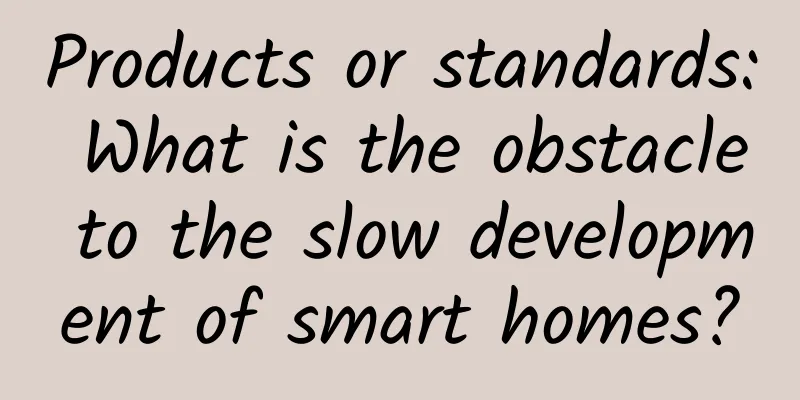Products or standards: What is the obstacle to the slow development of smart homes?

|
On January 13 this year, Google announced that it would acquire smart home device maker Nest for US$3.2 billion in cash. This lucrative acquisition officially kicked off this year's smart home industry war. As early as the CES2014 International Consumer Electronics Show at the beginning of the year, many domestic manufacturers such as Changhong, Haier, Hisense, TCL, Konka, and Skyworth launched their own smart home products. Even e-commerce companies that are not directly related to the home industry, such as domestic e-commerce giant JD.com, have officially launched the Broadlink series of products including smart sockets, smart remote controls, smart air detectors and wall switches for the smart home field. Today, all types of technology brands, whether emerging Internet companies or traditional home appliance manufacturers, are almost all related to the smart home industry in one way or another. From smart TVs equipped with Android operating systems to smart routers with processors, memory and other parameter indicators, smart home products of various forms are also expanding and beginning to flood the market. However, it must be said that although some smart home products have gone through several generations, the entire smart home industry is still "out of touch with the ground". Smart home manufacturers are having fun in their own "circles", but the real impact on consumers is very small. Even for most consumers, they don't even have a clear concept of "what a smart home is". What is the problem here? Products "taken for granted" "Completed" and "done well" mean two completely different results. When it comes to today's smart home products, most manufacturers are often eager to turn their ideas into reality, but there are still many imperfections in the products themselves. Among these, unclear product positioning is the most prominent problem, and has even become the main reason why smart home products are generally "not easy to use". The industry has discussed more than once whether all products need to be intelligent. However, in the view of some smart home manufacturers, the word "smart" is merely regarded as a "selling point". The products are completely "smart for the sake of being smart". The lack of optimization and usage scenario functions makes "intelligence" run counter to its original intention of "helping users more effectively". Take the smart socket, which has the lowest cost in the smart home industry, for example. To a certain extent, this is a product born out of "geek" thinking. Although mobile terminal devices such as smartphones have become the most common smart products, it is obviously a bit "taken for granted" to let "non-geek" family members who have just become familiar with smartphones use their phones to control sockets. The industry is not standardized enough If we judge from the fact that any industry is always groping forward in its early days, it is only a matter of time before smart home products gradually get better. However, according to the current situation, the lack of industry standards will become an important reason why the entire smart home industry will be struggling for a long time. Examples of products made in accordance with industry standards abound in the technology industry. From USB interfaces and Bluetooth connection technology to Wi-Fi wireless networks and NFC near-field communications, mature standards link different products more efficiently and make device manufacturers more standardized. Consumers and users will also feel the benefits invisibly. As for the smart home industry, the current situation is that manufacturers are fighting on their own. The few domestic home appliance manufacturers that have built a "smart home platform" strategy only focus on their own smart home products. It is difficult to integrate the control end of brand A's smart TV and brand B's smart air conditioner into the same mobile app. This also shows that the so-called platformization nowadays is just a different form of "independent existence". Even if a manufacturer wants to become the setter of industry standards, it is difficult to achieve under this premise. On the other hand, the concept of open platform is also included in the future development plans of many smart home manufacturers, but does open platform really mean "open"? As a giant in the traditional home appliance industry, Haier recently established its U+ smart life operating system as a fully open system platform, and has opened the API and SDK of the U+ system, actively encouraging developers to develop third-party applications for the U+ system, attracting the attention of many industry leaders such as Baidu, Tencent, Procter & Gamble, Oracle, Qualcomm, etc. However, the participation of these companies is undoubtedly still serving a brand. Whether the open platform access point is to make up for its own weaknesses, or whether it really wants to form connections and interoperability with other brands of smart home products, the purpose of this move is worth thinking about and discussing. The problem that the smart home industry has faced at this stage is that, on the surface, the products themselves are not good enough or even taken for granted, and are not attractive enough to the market. The lack of industry standards, which is more serious than that of other smart industries, is a potential hidden danger on the other side. The obstacle to the development of smart homes lies not only in the improvement of products but also in the urgent need to establish industry standards. A true smart home product is far more than just making a "product". As a winner of Toutiao's Qingyun Plan and Baijiahao's Bai+ Plan, the 2019 Baidu Digital Author of the Year, the Baijiahao's Most Popular Author in the Technology Field, the 2019 Sogou Technology and Culture Author, and the 2021 Baijiahao Quarterly Influential Creator, he has won many awards, including the 2013 Sohu Best Industry Media Person, the 2015 China New Media Entrepreneurship Competition Beijing Third Place, the 2015 Guangmang Experience Award, the 2015 China New Media Entrepreneurship Competition Finals Third Place, and the 2018 Baidu Dynamic Annual Powerful Celebrity. |
<<: Is it reliable for celebrities to cross over and start e-commerce businesses?
>>: Juniper: Global smartphone shipments to reach 1.2 billion this year
Recommend
What is the most effective way to promote Xiaohongshu notes? Notes on promotion!
In fact, to answer this question, we can talk abo...
Why does the last 1% of battery in a mobile phone last so long?
How would you feel when your phone only has 1% ba...
A large wave of spam animations is coming
Source code introduction: Compared with the previ...
Thanks to Chinese companies, Qualcomm's profits are higher than Apple's
Just as the National Development and Reform Commis...
Qinghai: Protecting the beautiful background of China's water tower and surging "green energy" in the sky
What is Qinghai? It is the source of the Yangtze ...
Apple, the big brother, takes the lead in smartphones changing from hard to soft
Last week, Apple did something unconventional and...
【Smart Farmers】Traveling around the world: A “footprint map” of genetically modified crop cultivation
【Smart Farmers】Traveling around the world: A “foo...
Is there any difference between Douyin Feed and Dou+?
"Should the live broadcast room be put into ...
The fastest animal in the world may be a relative of your bed! | Species Chat
In 2014, a mite named Paratarsotomus macropalpis ...
How difficult is it to produce the blue fireworks in the TV series "Nothing But Thirty"?
In the TV series “Nothing But Thirty”, “blue fire...
Selling 196 million in one day, how did Himalaya achieve growth?
Himalaya was established in 2012. Its previous po...
Want to improve product retention rate? Starting from these 4 methods
Retention rate is the most important indicator to...
How to create a popular brand?
Back in 1911, if you had a typewriter company, ho...
How to teach your girlfriend programming?
[[146883]] Ever since I started as a software dev...
Shanxi, the "sleeping province", has also become popular! Is the "nap gene" not groundless?
It is said that the two things that a Shanxi pers...









